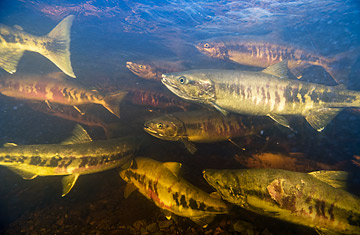
The sea doesn't give up its secrets easily. Water may cover 70% of the planet, but unless you get inside it — often very deep inside it — you don't know a lick about what's going on. That's especially problematic when it comes to protecting endangered or threatened species. Conservationists monitoring tiger or wolf or polar-bear populations need merely trek into the jungle or fly overhead and they can take a nose count. But tuna? Swordfish? Sharks? They're not so easy to keep track of.
Now, an ecologist with the National Oceanic and Atmospheric Administration (NOAA) has come up with an imaginative way to monitor stocks of one of the world's favorite and most beleaguered species of fish: salmon. The trick? Enlist seals as your census takers.
Scientists have been trying to follow the comings and goings of fish for more than a century. As long ago as 1873, the U.S. Fish Commission began catching salmon and attaching a kind of dog tag to them in an attempt to learn more about their peripatetic ways. The basic method hasn't changed much since then, though today the tags emit signals unique to each animal, and larger specimens can carry heavier tags that gather oceanographic data, such as depth and temperature.
But even the best tag technology is limited. Transmitters, after all, need receivers, and these have generally been installed in fixed spots like ocean shelves. If you don't have a pretty good idea in advance of where your fish are likely to be swimming, they may never pass close enough to download their data. That lack of information can be particularly damaging to salmon populations, which have been fluctuating wildly.
"In the Central Valley [of California] in 2002, we had about 800,000 king salmon [returning to their spawning grounds]," says Bruce MacFarlane, a NOAA ecologist and salmon specialist. "Last year, we had something like 40,000. What's causing that? Well, if you don't know where they're spending their time, you have no way of knowing."
It took Sean Hayes, another NOAA scientist, and his research team to decide that the answer was to draft the elephant seal: glue a transponder to the submarine-esque animal's hide, release it back into the wild and the odds are pretty good it will always be near at least a few salmon, since the two species favor the same kinds of water and have similar traveling patterns. Indeed, in central California, both species even return to the same stretch of coast near Hayes' lab in Santa Cruz, where receivers can be removed from the seals and the data read.
"Elephant seals cover so much ground over the North Pacific," Hayes says. "They get out into the open ocean habitat where we just don't have receivers." What's more, the animals work cheap. "The cost of deploying the tags on an elephant seal for a year is the equivalent of what it costs us to go out and track a fish for a day in a ship."
So far, the project is only in a pilot phase, and Hayes realizes that it has hurdles to overcome. Even the fairly predictable elephant seal may wander off and elude recapture, and there's always a chance the animal itself — along with the equipment it's carrying — could wind up in the least desirable place of all: the belly of a great white. Still, it's worth a try. The Northwest fishing industry has been devastated in recent years, due in part to a salmon "stock collapse" likely caused by some combination of higher water temperatures, overfishing and oceanic pollution. But no one can say for sure, and the seals could help solve the mystery.
If Hayes' project does succeed, it could not only aid the salmon, but could also be a crucial step toward building a much larger oceanographic network. Commercial and military vessels already traveling on their own routes could carry the same kind of receivers, and as the transmitting tags get smaller and cheaper, they could be put on a greater number of fish and mammals.
"If we have information on the habitats of fish species going through severe depletion, we can better set quotas," says Sara Iverson, scientific director of the Ocean Tracking Network, a Canadian research outfit that is looking into the fish-tracking problem as well. "We can stay out of the way in areas where they're spawning and change the ways in which we use the ocean." That change can't come soon enough — both for the fish and for ourselves.
